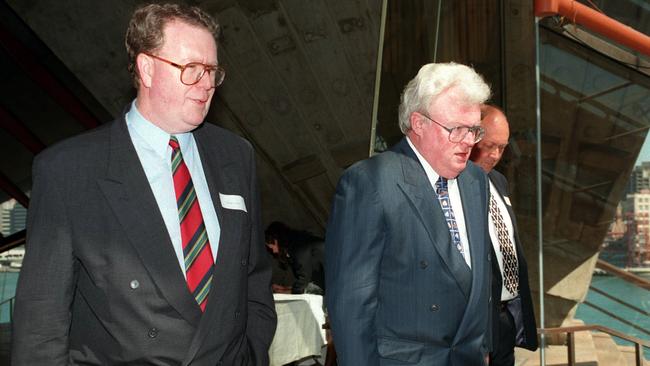Loosley speaking: Musings of a Labor senator in Machine Rules
The former senator relishes an opportunity to look back and tell some tales, but their relevance is questionable.

Stephen Loosley made his reputation as one of the hard men of the NSW Labor Right, and in his day that was thoroughly deserved. But on the evidence of this book he has mellowed considerably, especially since leaving the Senate in 1995. Machine Rules seems an opportunity for him to look back and tell some stories.
Loosley started on the Left, coming up through the anti-Vietnam War movement (although his parents had supported Robert Menzies). But he quickly realised the Left was more interested in purity and protest than getting things done. His connection with another machine man, Graham Richardson, who pops in and out of the book, led him to the NSW Labor Right, the ‘‘whatever it takes’’ faction (to borrow the title of Richardson’s 1994 book) that powered the party’s successes through the 1980s.
For a long time, Loosley was not especially interested in elective office, seeing his talents as more suited to the backroom. Entering the Senate in 1990 to sit on the backbench seems like a step down from roles such as NSW ALP secretary and ALP national president, and Loosley never properly explains it here. He says that after seven years he was “looking to move on”, although it does not sound convincing as a reason for the switch. He might have given us more to go on, especially as he later comments on the strain of parliamentary life on the family. Providing reasons is not Loosley’s strength, and indeed this points to a larger issue with the book: the rationale behind it is unclear.
It is not an in-depth political biography, as Loosley does not talk much about his thinking and philosophy. His political aim seems to have been to keep the wicked conservatives out of office. Is that all, in terms of objectives? One might have expected something more positive. But at least Loosley was, in his heyday, very good at it.
The problem is that Loosley’s heyday was a fair while ago. He gives a good account of the 1983 election — he was there and had close involvement — but it does not add much to what we already know. And it is hard to escape the fact that election was 32 years ago. He also spends a good amount of time talking about the Whitlam government.
There is an aspect of the ALP’s unhealthy obsession with itself here. Are we really interested in hearing about Bill Colbourne, a “legendary” NSW ALP general secretary in the 1950s and 60s? It’s collector-only stuff. Loosley sees the Hawke-Keating period as the gold standard for successful Labor reform governments, which is hardly a novel view. He adds that Neville Wran, then NSW premier, considered going to Canberra in the late 70s to rescue the struggling party but the timing never quite worked out. Again, this is no secret.
You keep expecting, and wanting, Loosley to talk about the Abbott government or the Rudd-Gillard-Rudd governments, or even the Howard era. (The Malcolm Turnbull era will have to wait for a revised edition.) But there are only glancing references, bits and pieces. Instead, in the second half of the book he goes off in another direction, providing a series of potted lessons about political operations.
This, presumably, is the ‘‘primer’’ bit. And it might be useful if you need to know how to rig electoral boundaries, chair a party conference or keep your supporters on the electoral roll even after they have died. The chapter on fundraising is also interesting: the trick is to know how to raise funds without looking as if you are raising funds. Loosley says he was always careful to tell donors there would not necessarily be a quo for the quid.
Well, maybe. Loosley sounds genuine, but this is the Labor Right we are talking about, and it might be noted that there is another chapter about how to say things that are — how might it be put? — not entirely founded in fact.
He has been around for long enough to know that absolute denials and unequivocal commitments often come back to bite you. Avoid them, he advises — although this is more difficult in the age of media saturation and the Twittering class.
He might be on safer ground when he speaks about the use of humour to defuse potentially dangerous situations. This requires a sense of self-deprecation — Ronald Reagan’s quip about having known Thomas Jefferson is an example Loosley cites — and that is in short supply these days, perhaps because the hyper-critical environment simply does not allow for it.
Could Loosley be as effective an operator in 2015 as he was in 1983? One cannot help but feel as if the lessons he offers are for a different, and bygone, era. The book starts to meander towards the end, with Loosley musing about sport, American politics and, somewhat strangely, the Spanish Civil War. Perhaps that is the dominant tone of the book: a musing chat. It lacks the exuberance of Richardson’s account of his chicanery, but neither is it a considered analysis of contemporary Australian politics.
Those interested in the back alleys of Labor politics will find some interesting material here but for the general reader there is not much that is new or insightful. This is a pity, because you want the book to be better, with the focus that Loosley showed in his political life.
Derek Parker is a freelance writer.
Machine Rules: A Political Primer
By Stephen Loosley
MUP, 210pp, $34.99



To join the conversation, please log in. Don't have an account? Register
Join the conversation, you are commenting as Logout